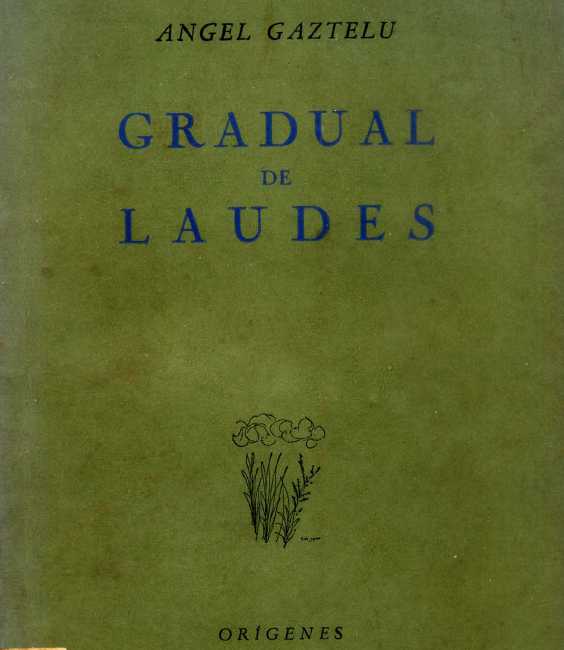4.1.2.4.3 The poetry collection “Gradual de laudes”, published by Angel Gaztelu (1914 – 2003) in 1955

“Gradual de laudes,” published in 1955 by Ángel Gatzelu, featured a lengthy and laudatory prologue by José Lezama Lima, entitled “Father Gaztelu in Poetry,” in which he traces, with his usual yet unique display of imagery, the author’s fruitful work in poetry and around “Orígenes.” The cultivation of the sonnet, among other classical forms, reached a certain splendor with Gaztelu, appreciated by Lezama:
“With Father Gaztelu, the sonnet became cantabile, moving from a voice rubbed with honey and as if reluctantly, to the second nature of song. The sonnet reached a murmur, became a fountain. The substance that stirred it carried a beachy root, ensuring the fixity of its mantle with the constant stirring of its flow and its blows from the sea.”
The collection of poems consists of seven sections, grouped according to the type of poetic composition but around relatively defined themes: “Décimas”, “Songs”, “Romances”, “Sonnets”, “Free Verses”, “Sacred Poems” and “Latin Versions”
The “Décimas” contain praises for the creatures of nature, flora, and fauna—including the snail, whose marine and musical essence captivates the poet—that implicitly allude to the creator of beauty. As a culmination of this section, there is a “Glosa,” so titled, a type of poetic composition in which the final verses of each stanza or poem are anticipated, forming part of an initial poem, in this case also about nature, “garden of doves.”
The “Songs” begin with a tribute to the founder of Portuguese theater, Gil Vicente. The rest of the “Songs” and also the “Romances,” with rich poetic nuances, constitute templates in which the author attempts to capture his participatory view of nature, fruitful but also painful, as is the case in his “Elegy,” to the pigeon, a victim of hunting.
Many of the “Sonnets” had already been published by the author in the Orígenes editions. They are exponents of a communion with the surrounding sensible reality, which they traverse like a slow arrow, always reaching the highest point. Among them are three pieces dedicated to and titled “Garcilaso de la Vega,” “Fray Luis de León,” and “San Juan de la Cruz,” and a sonnet of classical and relevant inspiration, chiseled, entitled “Signo”:
“Break this darkness that veils me
that glow that blooms my care.
Release the snow that freezes the vein
from the water that hits my side.
Open the stubborn fabric of the furrow
to the crowned dream of the ear of corn.
Unfurl the high sail to your star
to his sweet abandoned design.
And embrace the flame that calls
triumph that unappealably enchants.
Figures are that in the nocturnal plot
They oppose their passion to the ashes,
and tongues of laurel and green branch
against the dust that slides like a serpent.”
For his part, in “Free Verses,” Gaztelu includes many of the poems previously published in “Orígenes” and “Sacred Poems,” evidently based on religious worship, some of which had already been included in the magazine. “Latin Versions” contains the texts “Carmen de Pascua” and “Muy Pía Oración,” transpositions of topics from classical tradition.
This collection of poems constitutes a masterpiece as well as a synthesis of the bard’s creative work, according to Lezama “His first arrows of modernity reach the height of what contemporary philologists call parataxis: equal leveling of words in their ordering. In his poetic sentence no word is revealed on the island of its rescue. (…) The fervor for edification, the dedication to his duties, make the poetry of Father Gaztelu, fortunately beyond the poem, because a Catholic priest, lives through the carnality of his symbols poetry in its most traditional and tragic dimension.”








